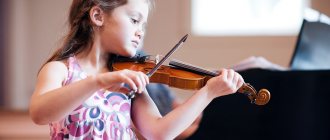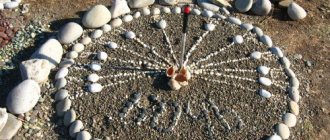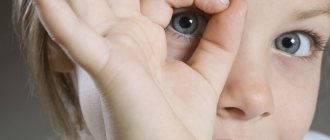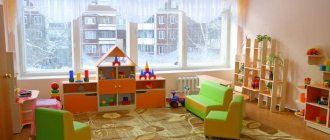Maria Savchenko
Experimental activities in the preparatory group. How to create a rainbow
Introduction
Every person at least once in his life admired a natural miracle - a rainbow . Many people have probably noticed that rainbows usually appear after rain. a rainbow many times , I wanted to know what a rainbow and how it appears, whether it is possible to get a rainbow artificially at home.
Purpose of the study: to find out whether it is possible to get a rainbow at home .
The object of study is the natural phenomenon of the rainbow .
The subject of the study is the types of rainbows and the possibility of obtaining them artificially.
Research problem: how to create different types of rainbows at home ?
Research objectives:
1. Find out what a rainbow and how it appears.
2. what types of rainbows exist in nature and is it possible to obtain them artificially?
3. Conduct experiments on obtaining a rainbow at home .
Hypothesis:
Let's assume that a rainbow can be obtained by replacing the sun's rays:
1. artificial light - lamp,
2. using water and felt-tip pens.
3. using Skitels
I have chosen will allow you to see a rainbow at home .
Basic methods: literature study, observation, experiment.
1.Relevance:
How does a rainbow ?
Since my senior year I have known the saying “Every hunter wants to know where the pheasant sits. From the initial letters of these sayings, I remembered the names and sequence of colors of such an unusual and beautiful natural phenomenon as a rainbow . Why does such a beautiful, and even colorful, picture appear in the air? Together with my teacher, we looked for the answer to this question in the encyclopedia, the Internet, and watched educational cartoons about rainbows . We learned that rainbows can be seen near waterfalls, fountains, and sprinklers.
Conclusion: a rainbow appears in sunny weather during rain, when the sun's rays pass through raindrops.
2. What types of rainbows exist .
a rainbow in the encyclopedia , I decided to find out what other rainbows exist .
A winter rainbow is a very rare phenomenon, because the refraction of sunlight occurs not in water droplets, but in ice crystals.
Hazy or white rainbow
It appears when a faint fog consisting of small droplets is illuminated by sunlight.
Red rainbow
In the last five or ten minutes before sunset, all the colors of the rainbow except red begin to disappear and finally only a single red arc remains.
Practical part
Rainbow is a miracle of nature . Is it possible to create this miracle yourself , at home? I decided to try this and conducted several experiments together with my teacher.
Experience No. 1 “ Creating a rainbow at home ”
Experiment No. 1: “Walking” water
To get started, you will need a set of the following materials:
Five transparent glasses of the same height (plastic cups will do);
Paper towels (napkins);
Water (tap);
Food coloring (three colors);
1. Have your child fill three cups with water and have them add coloring to each one;
2. Place an empty glass between two filled with colored water;
Ask your child if he knows what gravity is? If he doesn't already know this, explain that gravity is the force that attracts objects to each other. In this experiment, gravity will help the water move faster into an empty container.
3. Help your child fold the paper towel in half several times to create a long, thin strip about 2-3 cm wide. Repeat with the other paper towel (napkin) again;
4. Ask him to dip one end of a paper towel strip into a container of colored water and place the other end of the strip into an empty glass. Thus, the dry edges of two paper towels should fit into the dry cup.
All you have to do is wait - the water will begin to flow into the empty container within a few minutes; While you wait, make some predictions with your child: Will the water actually flow and how long will it take? What happens when you put two different colors together?
In a couple of hours you will see much more impressive results.
YouTube
Preparatory stage
To conduct the “Rainbow in a Glass” experiment in kindergarten, the teacher can learn a rhyme with the group that helps them remember the order of the colors of the rainbow. This will be the main spell. Let the kids taste the water, decide what color it is, add a little color and mix. They will see that the liquid completely changes color. Experimentation will teach children to be careful when handling water, develop fine motor skills and reasoning skills.
What will you need for the experiment?
To demonstrate the Rainbow in a Glass experiment for preschoolers, some simple preparations are required. Each participant must have the following set on the table:
- granulated sugar or salt, about 0.5 kg;
- 6 plastic cups (more is possible);
- food coloring or gouache 5 colors;
- warm water;
- syringe without needle;
- napkin and sheet of thick cardboard;
- colored markers;
- small mirror;
- flashlight.
Children may need help mixing ingredients carefully and maintaining proper proportions.
Experiment No. 2: Visually about the density of matter
An even simpler experiment in which you will need:
Transparent container (glass or jar);
Food coloring;
Liquids of different densities - for example, honey, vegetable oil, liquid soap, glycerin, water, alcohol, milk, and so on;
And also small objects: some kind of steel bolt, a piece of glass, rubber and, for example, paraffin.
1. We tint colorless liquids using dye;
2. We take a glass and carefully pour denser liquids into it first - for example, honey, milk, liquid soap, water, vegetable oil, motor oil, alcohol, and so on. Try to do this with your child so that he has an interest in participating in the process;
3. Carefully, without shaking or mixing the liquid, lower various objects into the container. Since their density is also different, they will be distributed on the surfaces of different liquids.
Ta-dam! This experiment will clearly show what the density of matter is.
YouTube
IMPORTANT! If you pour substances not intended for human consumption into the container, we throw it away after the experiment so that no one accidentally drinks from it afterwards.
see also
Production of liquefied argon, interaction of cesium with water and other fascinating video experiments
Description of the experience
For many experiments, ingredients that are found in any home are enough. Rainbow in a glass is an experience for children that will introduce them to the properties of water. This theme combines three different experiences that can be carried out in a kindergarten group or at home. They do not require special devices or reagents, and the participants will love the multi-colored result of the trick. The first experiment reveals the concept of water density, the second - the absorbency of paper, and the third - the refraction of light.
A description of the “Rainbow in a Glass” experiment for children can be found in video format; its preparation requires a little time and gouache or food coloring of several colors.
Experiment No. 3: “Slowing the Fall”
No less simple, but such a cool, almost “magical” experiment!
For it we will need:
Copper thick-walled tube with a hole diameter of 2-3 cm;
A neodymium magnet, whose outer diameter should be a couple of millimeters smaller than the inner diameter of the tube.
Attention! Despite the only two elements required for the experiment, getting them will not be so easy, but you will definitely like the result, and your child will simply be delighted with it!
1. To begin with, we demonstratively drop the magnet without the tube. It will fall, like any other object, to the floor in a split second;
2. Now we take our metal blank and throw a magnet into it, like this:
YouTube
A beauty, isn't it? We are sure that your child will instantly want to play with a new toy, regardless of age, 4, 5, 10 years or more. Give him this opportunity.
Explaining from a textbook that a falling magnet changes the magnetic flux in the pipe in such a way that it induces (induces) an electric current, the direction of which is determined by Lenz's rule, which in turn generates a magnetic field, will most likely be too early (and even then if you are in you figure this out yourself), but you will most likely be able to amaze a child and, perhaps, give him a desire to engage in interesting, entertaining science.
The meaning of the word "rainbow" in encyclopedic dictionaries
From the Explanatory Dictionary of the Russian Language by S.I. Ozhegov. , we learned that:
A rainbow is a multi-colored arc in the sky, formed as a result of the refraction of sunlight in raindrops.
According to the New Encyclopedic Dictionary of Brockhaus and Efron:
Rainbow is a well-known optical phenomenon in the atmosphere; observed when the sun illuminates a sheet of falling rain and the observer is between the sun and the rain. This phenomenon appears in the form of one, or less often, two concentric light arcs drawn in the sky from the direction of falling rain and colored flowers.
The inner, most often visible arc is colored red on the outer edge and violet on the inner edge; Between them, in the usual order of the solar spectrum, lie the colors: red, orange, yellow, green, blue and violet. The second, less frequently observed arc lies above the first, is usually more weakly colored, and the order of the colors in it is reversed.
According to V. Dahl's dictionary:
Rainbow is a modified version of the word "rayduga", or God's arc.
Experiment No. 4: “Newton’s Cradle with your own hands”
For the experiment you will need:
Three bottles of the same volume filled with water (half a liter will be enough);
Ball, ball (not very big, but massive enough that it could knock down one bottle like a pin).
The experiment has begun!
1. We place the skittle bottles one after another;
2. We launch the ball into the bottle. Having done this, you will see that the last bottle in the row will fall.
Before you let your child have fun with physics, briefly explain to him that this is called Newton’s cradle (pendulum) effect, which demonstrates to us the transformation of energy of different types into each other: kinetic into potential and vice versa.
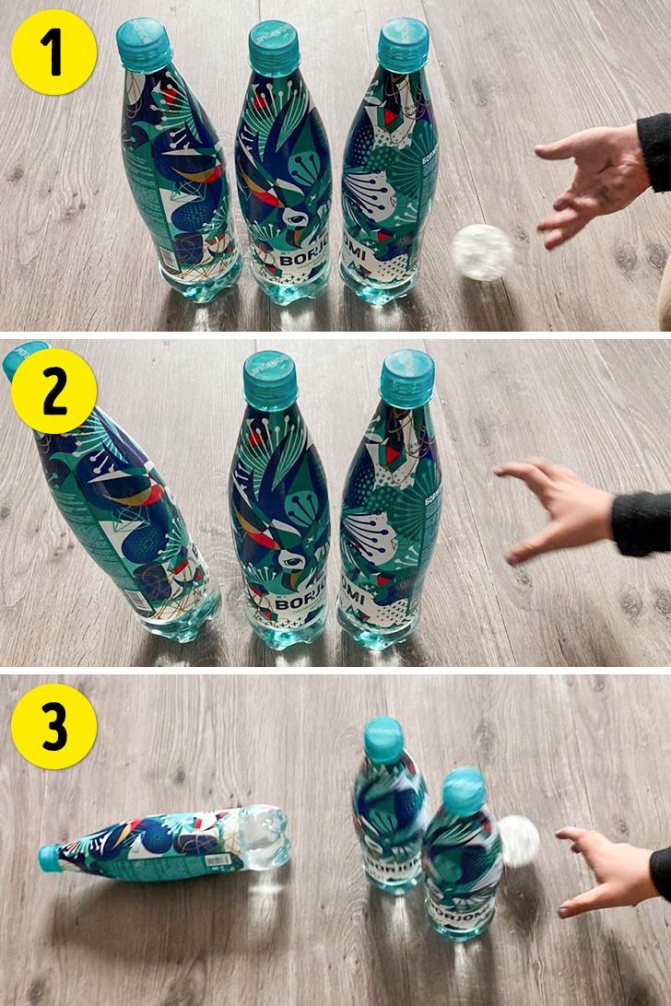
adme.ru
see also
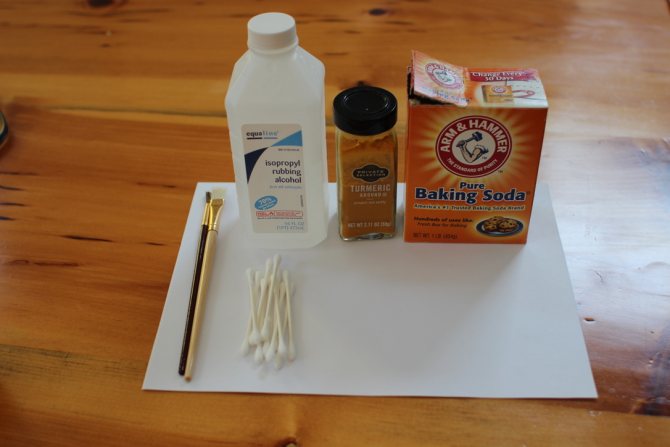
Two methods for making homemade invisible ink: one tested (works)
Experiment No. 5: Making a transparent egg shell
From physical experiments to chemical experiments.
You will need:
A raw egg;
Table vinegar.
The experiment is quite long (from a day to two), but the end result, we are sure, is worth it!
1. Pour vinegar into a container. It is advisable to use 9 percent vinegar;
2. We immerse the whole egg in the liquid so that the shell is completely hidden under its level;
3. We wait a day or two.
The point of the experiment is that vinegar will eat away the calcium that makes up the shell, leaving only the inner film between the protein and the shell. In this case, the protein itself will thicken from interaction with vinegar.
It is interesting that calcium carbonate, of which the shell is mainly composed, will begin to release carbon dioxide as it disintegrates. You can also tell your child about this. It's interesting and educational!
Attention! Eggs should not be eaten! You've seen what vinegar does to protein...
[media=
https://youtu.be/7VhsyMU_8UU
]
YouTube
Here are more advanced experiments with chicken eggs:
YouTube
The appearance of rainbows in nature
Rainbows can be seen before or after rain. And only if, at the same time as the rain, the sun breaks through the clouds. The sun's rays pass through raindrops. And each such droplet divides the white light of the Sun into its components - rays of red, orange, yellow, green, blue, indigo and violet. Moreover, droplets deflect light of different colors in different ways, as a result of which white light is decomposed into a multi-colored band, which is called a spectrum. (Appendix 2)
The shape of a rainbow is determined by the shape of the water droplets (they are more or less round) in which sunlight is refracted. Therefore, to an observer on earth, a rainbow usually looks like an arc - part of a circle.
You can only see a rainbow if you are strictly between the sun and the rain.
Sometimes you can see another, less bright rainbow around the first one. This is a secondary rainbow, in which the light is reflected twice in the drop. In a secondary rainbow, the order of colors is “inverted” - purple is on the outside and red is on the inside.
The appearance of the rainbow, the brightness of the colors, and the width of the stripes depend on the size and number of droplets in the air. The larger the raindrops, the brighter the rainbow. If the drops are small, the rainbow appears pale and barely noticeable.
However, rainbows can be seen not only after rain. In winter, when there is severe frost, ice crystals “float” in the air. They can also divide white into the seven colors of the rainbow, so rainbows can be seen even in winter. Although this phenomenon is quite rare.
Experiment No. 6: Creating a Rainbow Arc
Experiment kit:
Tray:
Mirror;
Water;
Flashlight;
A piece of white paper.
1. Fill the tray halfway with water;
2. We immerse the mirror in it as shown in the photo below, but you can do it completely:
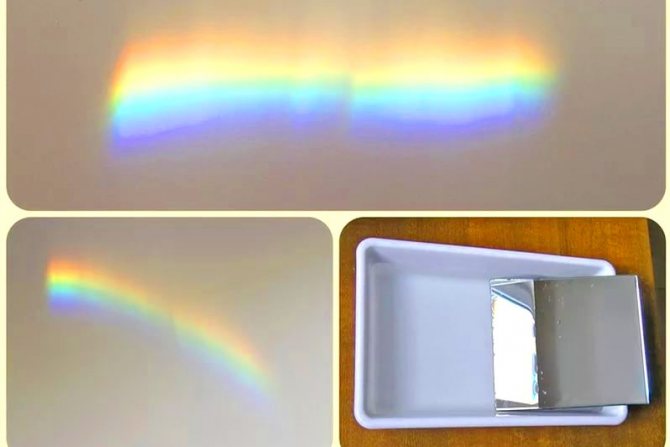
center-sozvezdie.ru
3. Place a sheet of white paper on the opposite side;
4. We direct the turned on flashlight at the mirror so that the reflected light hits the paper. And here it is - RAINBOW!
YouTube
This is how dispersion occurs - the decomposition of white light into a spectrum (rainbow). After such a visual and colorful experience, a 5th or 6th grade student, if you explain to him what dispersion is, will most likely even remember this concept even before starting the physics course.
see also
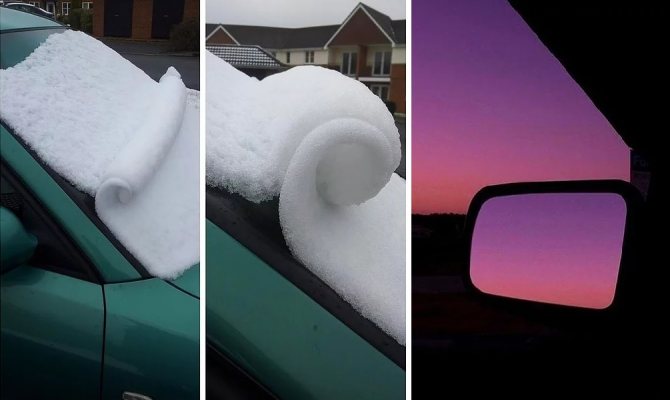
20 photos showing the beauty of the world found in simple things
Myths about the rainbow
Rainbow is a magnificent colorful phenomenon that has long captured the imagination of people. Looking at a rainbow, you want to believe in miracles and magic. Maybe that's why humanity has associated the rainbow with many myths and legends.
In Christianity, the rainbow symbolized forgiveness, a contract between God and man, a sign that from now on there will be no more global flood.
In the Christian symbolism of the Middle Ages, the three main colors of the rainbow are interpreted as images of the global flood (blue), global fire (red) and the new earth (green).
In China, they believed that the rainbow was a heavenly dragon, the union of Heaven and Earth.
The Western Slavs have a belief that a witch can steal a rainbow and hide it, which means causing drought on the earth.
The Irish leprechaun hides a pot of gold in the place where the rainbow touched the ground.
According to the beliefs of many African peoples, the rainbow is a heavenly snake that serves as a guardian of treasures, and in those places where the rainbow touches the ground, treasure can be found.
And in the mythology of the Australian aborigines, the Rainbow Serpent is considered the patron of water and rain.
Experiment No. 8: “Non-Newtonian fluid” at home
For the experiment you will need:
container (for example, tray);
starch;
water;
dye.
1. Pour the starch into a container;
2. Mix with water in a ratio of 2 to 1 (according to other sources, the proportion should be 1 to 1). That is, there should be half as much water as starch (as shown in the video below);
3. Mix thoroughly to obtain a homogeneous thick mixture. If necessary, add more starch for thickness;
4. Add dyes (optional, this will not affect the quality of the non-Newtonian liquid)
YouTube
Normally, in a container, the liquid will look like water and behave as such, but if you apply force to it, for example, sharply squeezing your palm while immersed in it, you will feel solid pieces. Between the fingers. Or, as in the experiment above, upon impact the liquid becomes very viscous, almost solid.
YouTube
Attention! Do not let your child beat the non-Newtonian liquid with his hand, only with some object, such as a pestle, to avoid injury.
see also
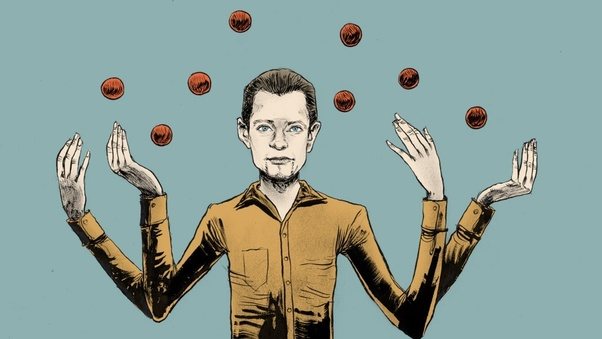
How to learn to juggle, and where to start?
How to explain "Rainbow" to preschoolers
An interesting lesson should be completed by explaining the properties of water. The teacher can tell the children that the denser the material - paper compared to a napkin - the slower it gets wet. Therefore, the dots from felt-tip pens take longer to spread.
The description of the “Rainbow in a Glass” experiment for children in the second version includes the following explanation: light consists of a full spectrum of colors, and with the help of a mirror it breaks up into its component parts.
In the third experiment, you need to tell that the more sugar or salt is dissolved in a glass, the denser the liquid becomes. This is why the colors don't mix.


